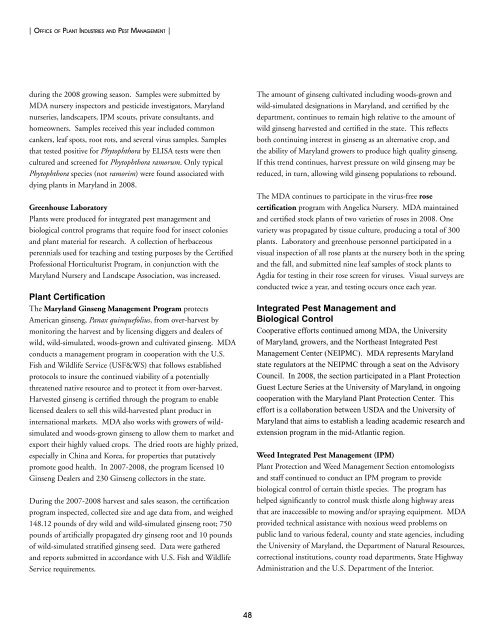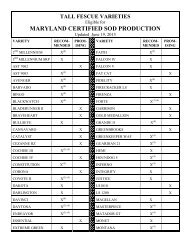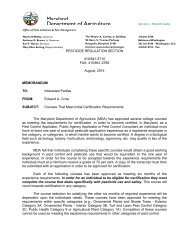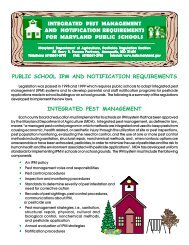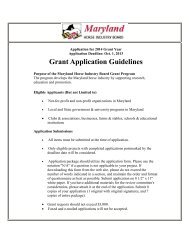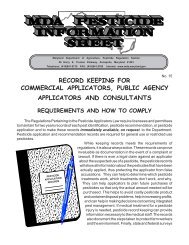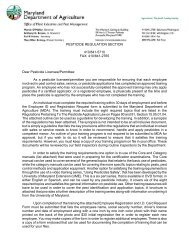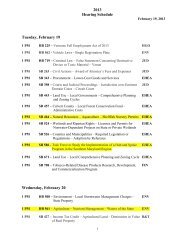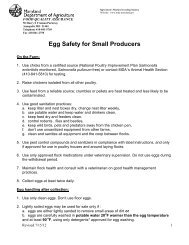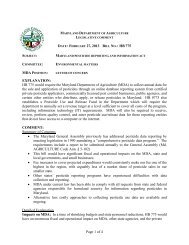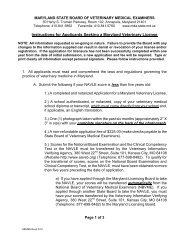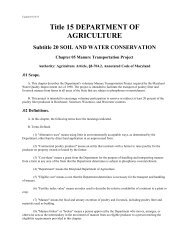| Office o f Pl a n t In d u s t r i es a n d Pest Ma n a g e m e n t |during the <strong>2008</strong> growing season. Samples were submitted by<strong>MDA</strong> nursery inspectors and pesticide investigators, <strong>Maryland</strong>nurseries, landscapers, IPM scouts, private consultants, andhomeowners. Samples received this year included commoncankers, leaf spots, root rots, and several virus samples. Samplesthat tested positive for Phytophthora by ELISA tests were thencultured and screened for Phytophthora ramorum. Only typicalPhytophthora species (not ramorim) were found associated withdying plants in <strong>Maryland</strong> in <strong>2008</strong>.Greenhouse LaboratoryPlants were produced for integrated pest management andbiological control programs that require food for insect coloniesand plant material for research. A collection <strong>of</strong> herbaceousperennials used for teaching and testing purposes by the CertifiedPr<strong>of</strong>essional Horticulturist Program, in conjunction with the<strong>Maryland</strong> Nursery and Landscape Association, was increased.Plant CertificationThe <strong>Maryland</strong> Ginseng Management Program protectsAmerican ginseng, Panax quinquefolius, from over-harvest bymonitoring the harvest and by licensing diggers and dealers <strong>of</strong>wild, wild-simulated, woods-grown and cultivated ginseng. <strong>MDA</strong>conducts a management program in cooperation with the U.S.Fish and Wildlife Service (USF&WS) that follows establishedprotocols to insure the continued viability <strong>of</strong> a potentiallythreatened native resource and to protect it from over-harvest.Harvested ginseng is certified through the program to enablelicensed dealers to sell this wild-harvested plant product ininternational markets. <strong>MDA</strong> also works with growers <strong>of</strong> wildsimulatedand woods-grown ginseng to allow them to market andexport their highly valued crops. The dried roots are highly prized,especially in China and Korea, for properties that putativelypromote good health. In 2007-<strong>2008</strong>, the program licensed 10Ginseng Dealers and 230 Ginseng collectors in the state.During the 2007-<strong>2008</strong> harvest and sales season, the certificationprogram inspected, collected size and age data from, and weighed148.12 pounds <strong>of</strong> dry wild and wild-simulated ginseng root; 750pounds <strong>of</strong> artificially propagated dry ginseng root and 10 pounds<strong>of</strong> wild-simulated stratified ginseng seed. Data were gatheredand reports submitted in accordance with U.S. Fish and WildlifeService requirements.The amount <strong>of</strong> ginseng cultivated including woods-grown andwild-simulated designations in <strong>Maryland</strong>, and certified by thedepartment, continues to remain high relative to the amount <strong>of</strong>wild ginseng harvested and certified in the state. This reflectsboth continuing interest in ginseng as an alternative crop, andthe ability <strong>of</strong> <strong>Maryland</strong> growers to produce high quality ginseng.If this trend continues, harvest pressure on wild ginseng may bereduced, in turn, allowing wild ginseng populations to rebound.The <strong>MDA</strong> continues to participate in the virus-free rosecertification program with Angelica Nursery. <strong>MDA</strong> maintainedand certified stock plants <strong>of</strong> two varieties <strong>of</strong> roses in <strong>2008</strong>. Onevariety was propagated by tissue culture, producing a total <strong>of</strong> 300plants. Laboratory and greenhouse personnel participated in avisual inspection <strong>of</strong> all rose plants at the nursery both in the springand the fall, and submitted nine leaf samples <strong>of</strong> stock plants toAgdia for testing in their rose screen for viruses. Visual surveys areconducted twice a year, and testing occurs once each year.Integrated Pest Management andBiological ControlCooperative efforts continued among <strong>MDA</strong>, the University<strong>of</strong> <strong>Maryland</strong>, growers, and the Northeast Integrated PestManagement Center (NEIPMC). <strong>MDA</strong> represents <strong>Maryland</strong>state regulators at the NEIPMC through a seat on the AdvisoryCouncil. In <strong>2008</strong>, the section participated in a Plant ProtectionGuest Lecture Series at the University <strong>of</strong> <strong>Maryland</strong>, in ongoingcooperation with the <strong>Maryland</strong> Plant Protection Center. Thiseffort is a collaboration between USDA and the University <strong>of</strong><strong>Maryland</strong> that aims to establish a leading academic research andextension program in the mid-Atlantic region.Weed Integrated Pest Management (IPM)Plant Protection and Weed Management Section entomologistsand staff continued to conduct an IPM program to providebiological control <strong>of</strong> certain thistle species. The program hashelped significantly to control musk thistle along highway areasthat are inaccessible to mowing and/or spraying equipment. <strong>MDA</strong>provided technical assistance with noxious weed problems onpublic land to various federal, county and state agencies, includingthe University <strong>of</strong> <strong>Maryland</strong>, the <strong>Department</strong> <strong>of</strong> Natural Resources,correctional institutions, county road departments, State HighwayAdministration and the U.S. <strong>Department</strong> <strong>of</strong> the Interior.48
| Office o f Pl a n t In d u s t r i es a n d Pest Ma n a g e m e n t |Weed IPM research activities were conducted at field plots atthe <strong>MDA</strong> facility in Cheltenham and along State HighwayAdministration rights <strong>of</strong> ways during each <strong>of</strong> the past eight years.These plots continued to be used for evaluation and to conductweed suppression trials. Additionally, plots long established atWestern <strong>Maryland</strong> Research and Education Center (WMREC)in Keedysville were supplemented in <strong>2008</strong> with newly plantedresearch plots. Integrated Pest Management investigationscontinued to be targeted at suppression <strong>of</strong> Cirsium and Carduusthistles. Research is focused on the evaluation <strong>of</strong> organisms forpotential biocontrol, testing herbicide formulation efficacy, andevaluating the use <strong>of</strong> competitive vegetation (including nativegrasses and forbs) in an effort to provide environmentally-soundand cost-effective methods for suppression <strong>of</strong> noxious thistlespecies in <strong>Maryland</strong>.Presentations regarding the progress <strong>of</strong> ongoing biocontroland weed management programs were made to State HighwayAdministration managers, staff and guests from other state agenciesat an SHA sponsored Vegetation Management Conference bythe staff entomologist coordinating the program and by WeedManagement Program staff. The staff entomologist and <strong>MDA</strong>Plant Protection Section Program Manager also met with SHALandscape Operations Division staff and administrators to reviewprogram accomplishments and progress, and to coordinate anddevelop a work plan for the next few years.A survey for the presence and effects <strong>of</strong> rose rosette disease wascontinued in <strong>2008</strong>. Rose rosette disease is a pathogenic malady<strong>of</strong> the multiflora rose, Rosa multiflora, a problem weed in pastures,woodlands, and rights <strong>of</strong> ways in <strong>Maryland</strong> and many other states.The disease, which has become established in North America andis spread by natural means, reduces populations <strong>of</strong> this invasiverose species.Since the disease was first detected in <strong>Maryland</strong> in the 1990s,results <strong>of</strong> surveys conducted by <strong>MDA</strong> Plant Protection andWeed Management staff indicate that the disease is continuing tospread over a wide portion <strong>of</strong> Central and Northern <strong>Maryland</strong>,and has become locally established in Southern <strong>Maryland</strong> andon <strong>Maryland</strong>’s Eastern Shore. In 2002, a field experiment to testthe relative susceptibility <strong>of</strong> various rose cultivars and native rosespecies to rose rosette disease was designed and implemented at the<strong>MDA</strong> facility in Cheltenham. Experimental results continued tobe recorded and accessed in <strong>2008</strong>. This experiment is intendedto provide valuable information needed to assess the effects <strong>of</strong> thedisease on rose species other than R. multiflora including nativespecies and cultivars important to the landscape and nursery tradein <strong>Maryland</strong>.This was another active year for releases <strong>of</strong> biological controlagents, the leaf-feeding beetles Gallerucella calmariensis and G.pusilla, on populations <strong>of</strong> purple loosestrife (Lythrum salicaria).During the summer <strong>of</strong> <strong>2008</strong>, more than 2,500 adult beetleswere released at several locations on the Patuxent River near JugBay and adjacent to the Merkle Wildlife Management Area. Anadditional 2,500 beetles were released along the Anacostia Riverbetween Bladensburg, Md and the U.S. National Arboretumin Washington, D.C. The first <strong>MDA</strong>-reared beetle adults andlarvae were also released in <strong>2008</strong>. Adult beetles were released incentral Howard County and adult beetles and larvae were releasedin southern Charles County near Port Tobacco. Partners withthe <strong>Maryland</strong> <strong>Department</strong> <strong>of</strong> <strong>Agriculture</strong> in these efforts arethe <strong>Maryland</strong> <strong>Department</strong> <strong>of</strong> Natural Resources, the <strong>Maryland</strong>-National Capital Park and Planning Commission, and the HowardCounty <strong>Department</strong> <strong>of</strong> Recreation and Parks. Funding for theproject was, in part, derived from funds dedicated by the <strong>Maryland</strong><strong>Department</strong> <strong>of</strong> Transportation, State Highway Administration.<strong>MDA</strong> was the primary coordinating agency.The rearing program move from Cheltenham to <strong>MDA</strong>’sheadquarters in Annapolis has proven to be successful as well asefficient. <strong>MDA</strong> staff reared beetles at the <strong>MDA</strong> greenhouse andrearing laboratories in Annapolis throughout the 2007 seasonand in <strong>2008</strong> were successful for the first time at bringing theadult beetles out <strong>of</strong> overwintering diapause and increasing beetlenumbers significantly over the course <strong>of</strong> the spring and summer.<strong>MDA</strong> staff is making preparations to increase production evenfurther in 2009.In addition to the releases and the rearing project described above,locations where beetles were previously released in Prince George’sand Howard counties were surveyed for the biocontrol agent;beetle activity was again detected. An average <strong>of</strong> 30,000 beetlesper year had been released over several years through 2003 toestablish populations <strong>of</strong> the leaf feeding beetles in field insectaries,to support field collections for biological control efforts, andto allow for redistribution in the future. Sites in Howard andPrince George’s counties where beetles were released in past yearswere evaluated for levels <strong>of</strong> plant control and were surveyed for49
- Page 5 and 6: Dear Friends,Since coming to office
- Page 9 and 10: | Office o f t h e Secretary |Offic
- Page 11 and 12: | Office o f t h e Secretary |USDA/
- Page 13 and 14: | Office o f t h e Secretary |Netwa
- Page 16 and 17: | Office o f Resource Co n s e r v
- Page 18 and 19: | Office o f Resource Co n s e r v
- Page 20 and 21: | Office o f Resource Co n s e r v
- Page 22 and 23: | Ma r k e t i n g, An im a l In d
- Page 24 and 25: | Ma r k e t i n g, An im a l In d
- Page 26 and 27: | Ma r k e t i n g, An im a l In d
- Page 28 and 29: | Ma r k e t i n g, An im a l In d
- Page 30 and 31: | Ma r k e t i n g, An im a l In d
- Page 32 and 33: | Ma r k e t i n g, An im a l In d
- Page 34 and 35: | Ma r k e t i n g, An im a l In d
- Page 36 and 37: | Ma r k e t i n g, An im a l In d
- Page 38 and 39: | Ma r k e t i n g, An im a l In d
- Page 40 and 41: | Ma r k e t i n g, An im a l In d
- Page 42 and 43: | Ma r k e t i n g, An im a l In d
- Page 44 and 45: | Ma r k e t i n g, An im a l In d
- Page 46 and 47: | Office o f Pl a n t In d u s t r
- Page 48 and 49: | Office o f Pl a n t In d u s t r
- Page 52 and 53: | Office o f Pl a n t In d u s t r
- Page 54 and 55: | Office o f Pl a n t In d u s t r
- Page 56 and 57: | Office o f Pl a n t In d u s t r
- Page 58 and 59: | Office o f Pl a n t In d u s t r
- Page 60 and 61: | Office o f Pl a n t In d u s t r
- Page 62 and 63: | Office o f Pl a n t In d u s t r
- Page 64 and 65: | Office o f Pl a n t In d u s t r
- Page 66 and 67: | Office o f Pl a n t In d u s t r
- Page 68 and 69: | Office o f Pl a n t In d u s t r
- Page 70 and 71: | Office o f Pl a n t In d u s t r
- Page 72 and 73: | Office o f Pl a n t In d u s t r
- Page 74 and 75: | Office o f Pl a n t In d u s t r
- Page 76 and 77: | Office o f Pl a n t In d u s t r
- Page 78 and 79: | Ma ry l a n d Department o f Agri


